Lime Production in the Late Chalcolithic Period: The Case of Arslantepe (Eastern Anatolia)
Abstract
1. Introduction
2. Archaeological Setting
3. Geological Setting
4. Materials and Methods
4.1. Materials
4.2. Methods
5. Results
5.1. Polarized Light Microscopy (PLM)
5.2. X-ray Powder Diffraction (XRPD)
5.3. Scanning Electron Microscopy Coupled with Energy Dispersive Spectroscopy (SEM-EDS)
6. Discussion
7. Conclusions
Author Contributions
Funding
Institutional Review Board Statement
Informed Consent Statement
Data Availability Statement
Acknowledgments
Conflicts of Interest
References
- Rollefson, G. The uses of plaster at Neolithic Ain Ghazal, Jordan. Archaeomaterials 1990, 4, 33–54. [Google Scholar]
- Wright, G.R.H. Ancient Building Technology. Volume 2, Materials; Brill: Leiden, The Netherlands, 2005. [Google Scholar]
- Baird, D. PinarbaŞi. Anatol. Archaeol. 2005, 11, 12–13. [Google Scholar]
- Sagona, A.; Zimansky, P. Ancient Turkey; Routledge: London, UK, 2015. [Google Scholar]
- Goren, Y.; Goldberg, P. Petrographic thin sections and the development of Neolithic plaster production in northern Israel. J. Field Archaeol. 1991, 18, 131–140. [Google Scholar] [CrossRef]
- Kingery, W.D.; Vandiver, P.B.; Prickett, M. The beginnings of pyrotechnology, part II: Production and use of lime and gypsum plaster in the Pre-Pottery Neolithic Near East. J. Field Archaeol. 1988, 15, 219–243. [Google Scholar] [CrossRef]
- Mercier, N.; Valladas, H.; Froget, L.; Joron, J.L.; Reyss, J.L.; Weiner, S.; Goldberg, P.; Meignen, L.; Bar-Yosef, O.; Belfer-Cohen, A.; et al. Hayonim Cave: A TL-based chronology for this Levantine Mousterian sequence. J. Archaeol. Sci. 2007, 34, 1064–1077. [Google Scholar] [CrossRef]
- Carran, D.; Hughes, J.; Leslie, A.; Kennedy, C. A short history of the use of lime as a building material beyond Europe and North America. Int. J. Archit. Herit. 2012, 6, 117–146. [Google Scholar] [CrossRef]
- Çamurcuoglu, D.S. The Wall Paintings of Çatalhöyük (Turkey): Materials, Technologies and Artists; UCL (University College London): London, UK, 2015. [Google Scholar]
- Baird, D. The Boncuklu project: The origins of sedentism, cultivation and herding in central Anatolia. Anatol. Archaeol. 2009, 14, 11–12. [Google Scholar]
- Esin, U.; Harmankaya, S. Aşıklı. In Neolithic in Turkey: The Cradle of Civilization, New Discoveries; Özdoğan, M., Başgelen, M., Eds.; Istanbul Arkeoloji ve Sanat Yayinlari: Istanbul, Turkey, 1999; pp. 115–132. [Google Scholar]
- Özdoğan, A. Çayönü. In The Neolithic in Turkey. New Excavations and New Research; Özdoğan, M., Başgelen, N., Kuniholm, P., Eds.; Archaeology and Art Publications: Istanbul, Turkey, 2011; pp. 185–269. [Google Scholar]
- French, D.H. Excavations at Can Hasan III 1969–1970. In Papers in Economic Prehistory; Higgs, E.S., Ed.; Cambridge University Press: Cambridge, UK, 1972; pp. 181–190. [Google Scholar]
- Gurdil, B. Architecture and Social Complexity in the Late Ubaid Period: A Study of the Bulk Environment of Değirmentepe in East Anatolia; University of California: Los Angeles, CA, USA, 2005. [Google Scholar]
- Hauptmann, H. Die Grabungen auf dem Norşuntepe. In Keban Project 1972 Activities; ODTU: Ankara, Turkey, 1976; pp. 21–78. [Google Scholar]
- Frangipane, M.; Fazio, G. Le pitture murali del palazzo Tardo Calcolitico di Arslantepe-Malatya (Turchia). In Sharing Conservation. Pluralità di Approcci alla Conservazione e al Restauro dei Manufatti Polimaterici; Pandozy, S., Ed.; Edizioni Musei Vaticani: Fiumicino, Italy, 2014; pp. 529–540. [Google Scholar]
- Balossi Restelli, F. Arslantepe VII. The Development of a Ceremonial/Political Centre in the First Half of the Fourth Millennium BCE (Late Chalcolithic 3–4); Abor Sapientiae: Rome, Italy, 2019. [Google Scholar]
- Liberotti, G. Studi o Multidisciplinare Sugli Elementi Costruttivi e Archi Tettonici in Terra Cruda: Il Tardo Calcolitico nel sito Archeologico di Arslantepe (Malatya, Turchia); Università degli Studi dell’Aquila: L’Aquila, Italy, 2010. [Google Scholar]
- Fragnoli, P.; Palmieri, A.M. Petrographic and geochemical investigations on the pottery production from Arslantepe—Malatya (Eastern Anatolia) from the fourth to the second Millennium BCE: Technological continuity, innovation and cultural change. Archaeometry 2017, 59, 612–641. [Google Scholar] [CrossRef]
- Liberotti, G.; Rovero, L.; Stipo, G.; Tonietti, U. Mechanical investigation on adobe samples belonging to the archaeological site of Arslantepe (Malatya, Turkey). CIAT2015 2016, 7, 3656–3666. [Google Scholar]
- Pecchioni, E.; Fratini, F.; Cantisani, E. Atlas of the Ancient Mortars in Thin Section under Optical Microscope; Nardini: Firenze, Italy, 2017. [Google Scholar]
- MacKenzie, W.S.; Guilford, C. Atlas of the Rock-Forming Minerals in Thin Section; Routledge: London, UK, 2014. [Google Scholar]
- Affonso, M.T.C. Identification of lime plasters. Old Potter Alm. 1996, 4, 1–6. [Google Scholar]
- Frangipane, M. Riflessioni sui fondamenti delle ‘economie politiche’ nelle società protostatali del mondo ‘mesopotamico’. In ‘My Life is like the Summer Rose’. Maurizio Tosi e l’Archeologia Come Modo di Vivere; Lamberg-Karlovsky, C.C., Genito, B., Cerasetti, B., Eds.; BAR Intern. Series 2690: Oxford, UK, 2014; pp. 251–262. [Google Scholar]
- Thirumalini, S.; Ravi, R.; Sekar, S.K.; Nambirajan, M. Knowing from the past—Ingredients and technology of ancient mortar used in Vadakumnathan temple, Tirussur, Kerala, India. J. Build. Eng. 2015, 4, 101–112. [Google Scholar] [CrossRef]
- Fusade, L.; Viles, H.; Wood, C.; Burns, C. The effect of wood ash on the properties and durability of lime mortar for repointing damp historic buildings. Constr. Build. Mater. 2019, 212, 500–513. [Google Scholar] [CrossRef]
- Pedraza, S.P.; Pineda, Y.; Gutiérrez, O. Influence of the unburned residues in fly ash additives on the mechanical properties of cement mortars. Procedia Mater. Sci. 2015, 9, 496–503. [Google Scholar] [CrossRef]
- Bakolas, A.; Biscontin, G.; Moropoulou, A.; Zendri, E. Characterization of the lumps in the mortars of historic masonry. Thermochim. Acta 1995, 269/270, 809–816. [Google Scholar] [CrossRef]
- Pesce, G.L.; Ball, R.J.; Quarta, G.; Calcagnile, L. Identification, extraction, and preparation of reliable lime samples for 14C dating of plasters and mortars with the “pure lime lumps” technique. Radiocarbon 2012, 54, 933–942. [Google Scholar] [CrossRef]
- Siddall, R.; Çamurcuoglu, D. Plastering the Prehistory: Marl as a unique material to cover, maintain and decorate the Neolithic walls of Catalhöyük. In Proceedings of the 4th Historic Mortars Conference HMC2016, Santorini, Greece, 10–12 October 2016; pp. 482–489. [Google Scholar]
- Hodder, I. Çatalhöyük in the context of the Middle Eastern Neolithic. Annu. Rev. Anthr. 2007, 36, 105–120. [Google Scholar] [CrossRef]
- Matthews, W. Life-cycle and life-course of buildings. In Çatalhöyük Perspectives: Reports from the 1995–1999 Seasons, Vol. 6; Hodder, I., Ed.; McDonald Institute for Archaeological Research: Cambridge, UK, 2005; pp. 125–150. [Google Scholar]
- Ospitali, F.; Smith, D.C.; Lorblanchet, M. Preliminary investigations by Raman microscopy of prehistoric pigments in the wall-painted cave at Roucadour, Quercy, France. J. Raman Spectrosc. 2006, 37, 1063–1071. [Google Scholar] [CrossRef]
- Fragnoli, P. Pottery production in pastoral communities: Archaeometric analysis on the LC3-EBA1 Handmade Burnished Ware from Arslantepe (in the Anatolian Upper Euphrates). J. Archaeol. Sci. Rep. 2018, 18, 318–332. [Google Scholar] [CrossRef]
- Wright, K.; Baysal, A. Cooking, crafts and curation: Ground stone artefacts. In Hanging Materialities at Çatalhöyük: Reports from the 1995–1999 Seasons; Hodder, I., Ed.; British: London, UK, 2005; pp. 307–324. [Google Scholar]
- Wright, K.; Tsoraki-Chan, C.; Siddall, R. The ground stone technologies of Çatalhöyük. In Substantive Technologies from Çatalhöyük: Reports from the 2000–2008 Seasons; Hodder, I., Ed.; Cotsen Institute of Archaeology, University of California in Los Angeles: Los Angeles, CA, USA, 2013; pp. 355–408. [Google Scholar]
- Goren, Y.; Goring-Morris, A.N. Early Pyrotechnology in the Near East: Experimental Lime-Plaster Production at the Pre-Pottery Neolithic B Site of. Geoarchaeol. Int. J. 2008, 23, 779–798. [Google Scholar] [CrossRef]
- Toffolo, M.B.; Ullman, M.; Caracuta, V.; Weiner, S.; Boaretto, E. A 10,400-year-old sunken lime kiln from the Early Pre-Pottery Neolithic B at the Nesher-Ramla quarry (el-Khirbe), Israel. J. Archaeol. Sci. Rep. 2017, 14, 353–364. [Google Scholar] [CrossRef]
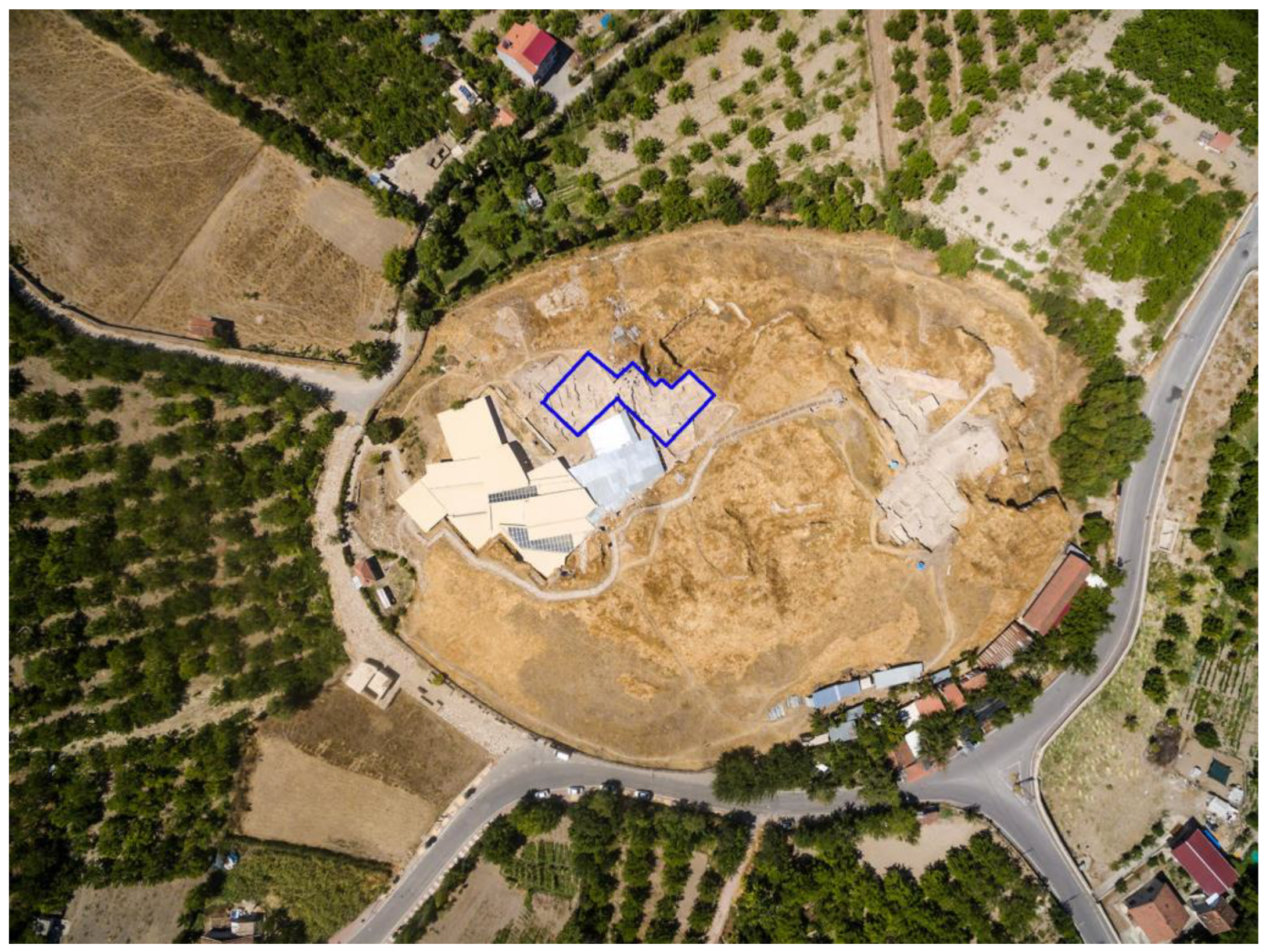
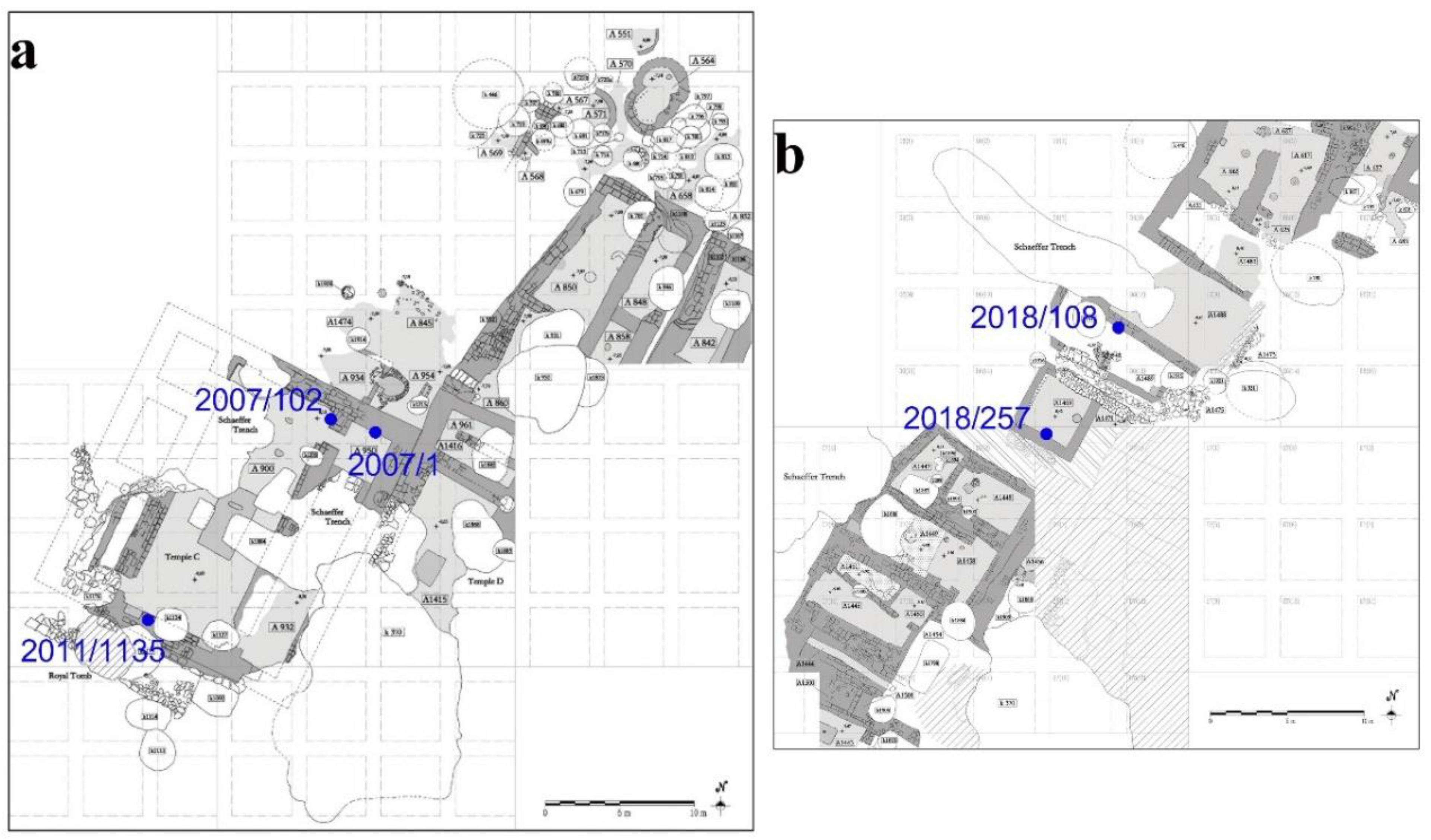
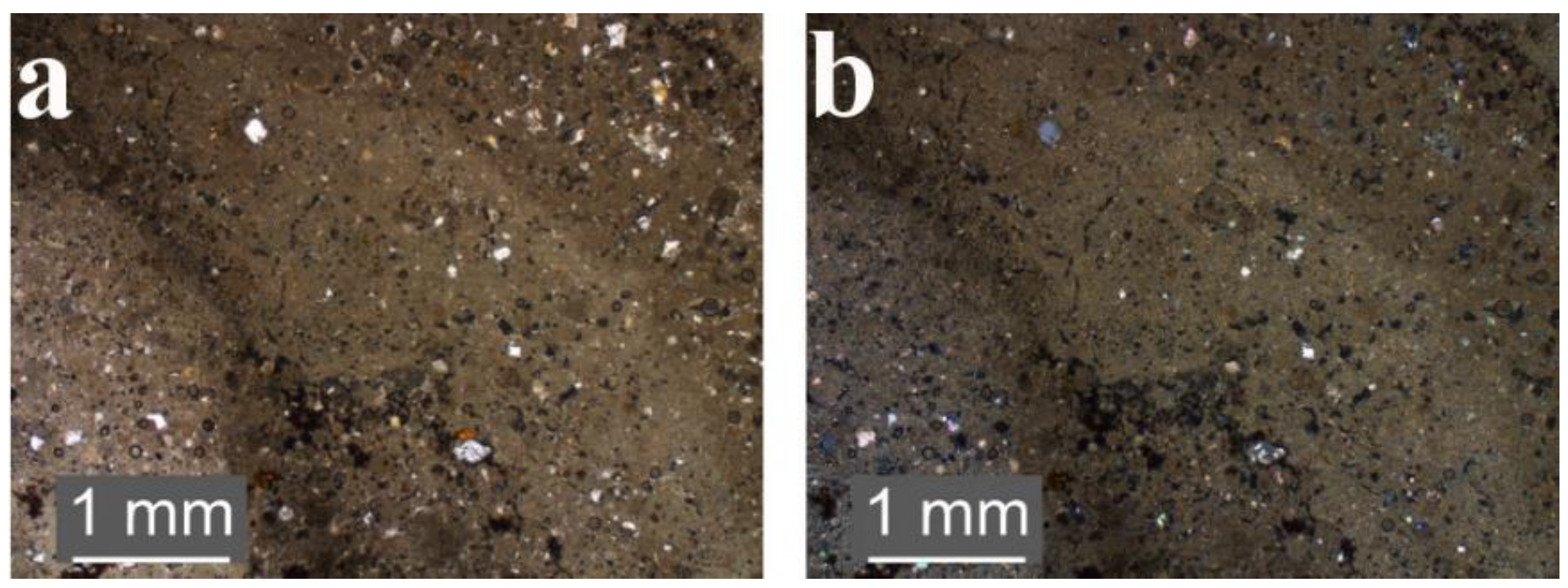
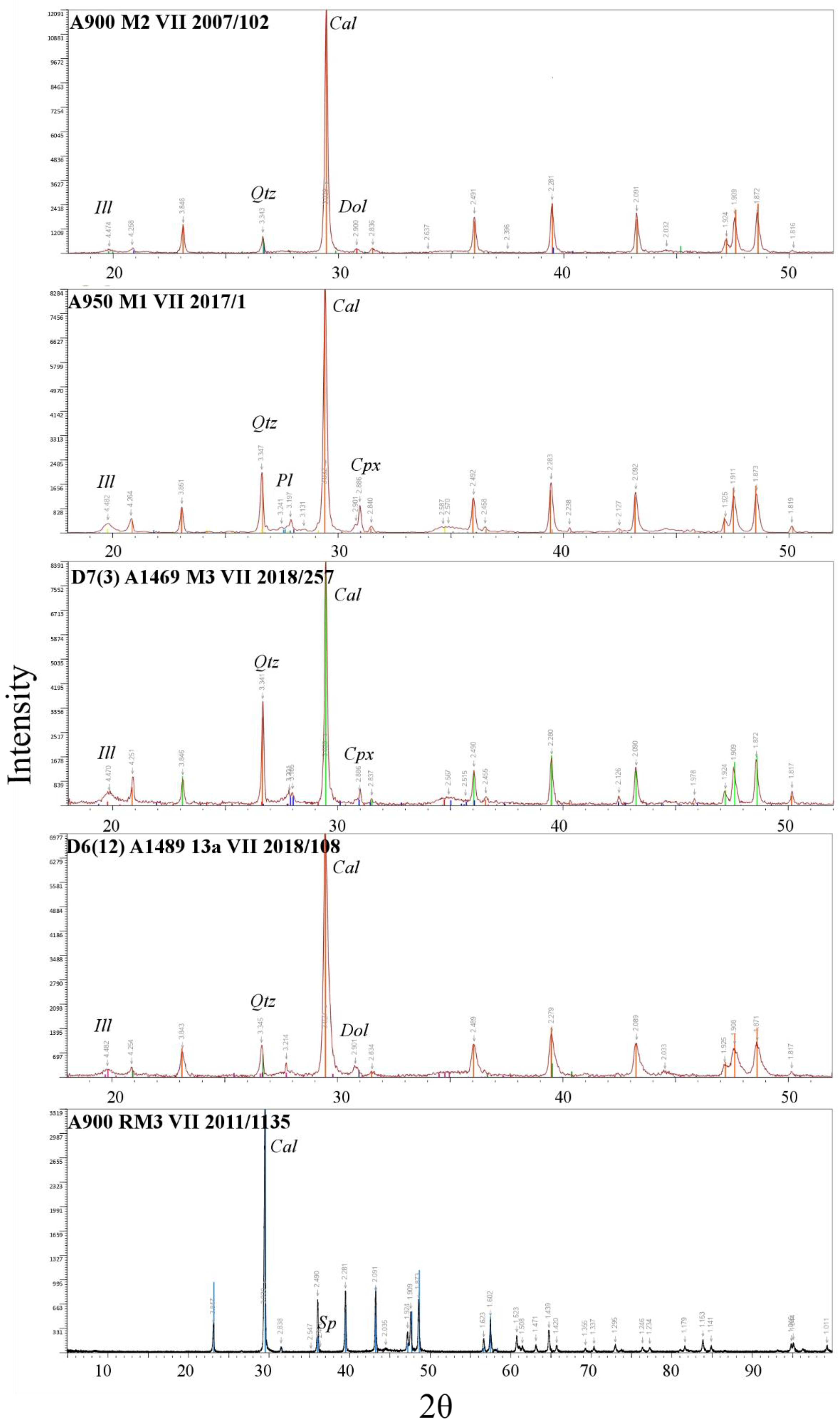
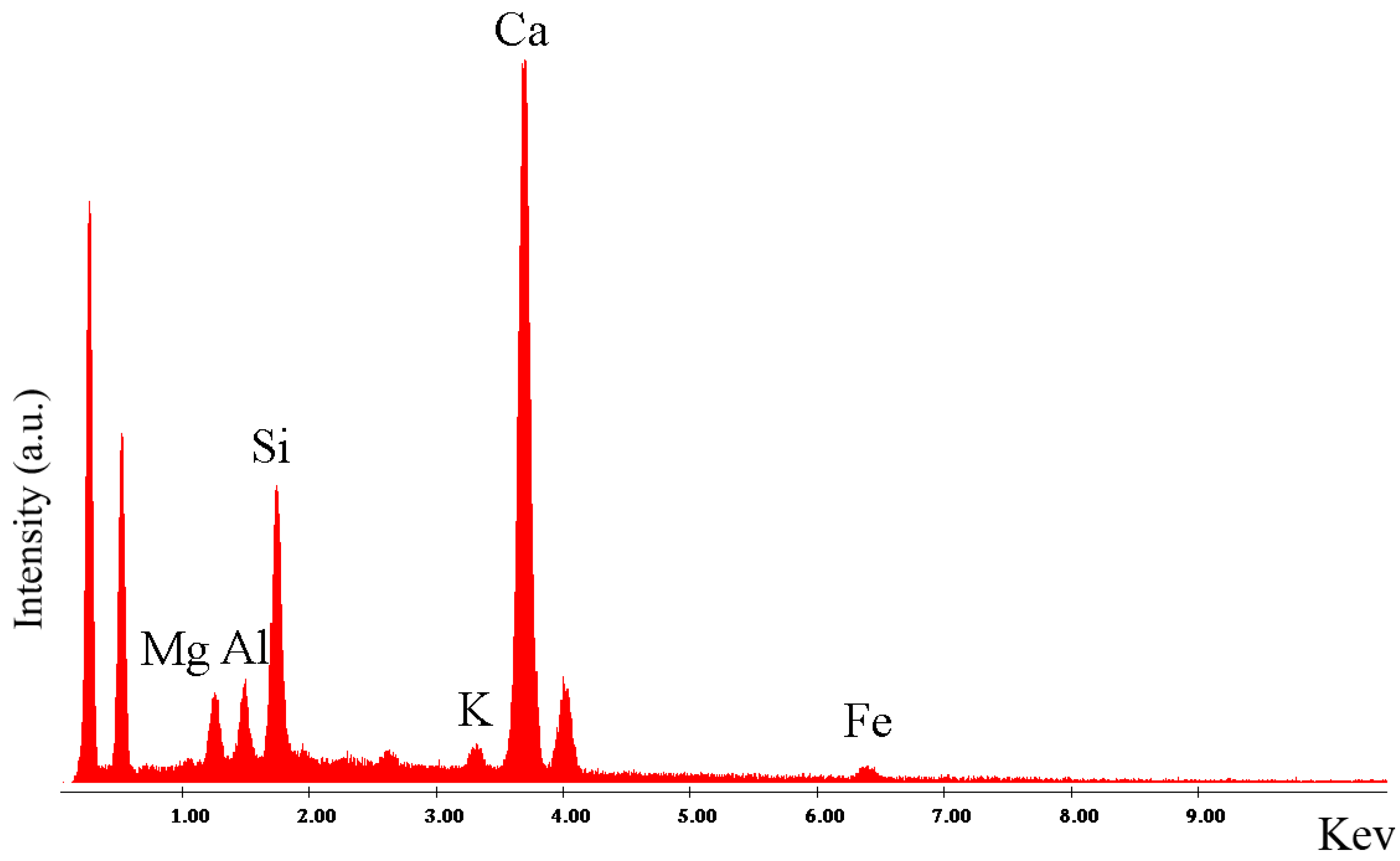
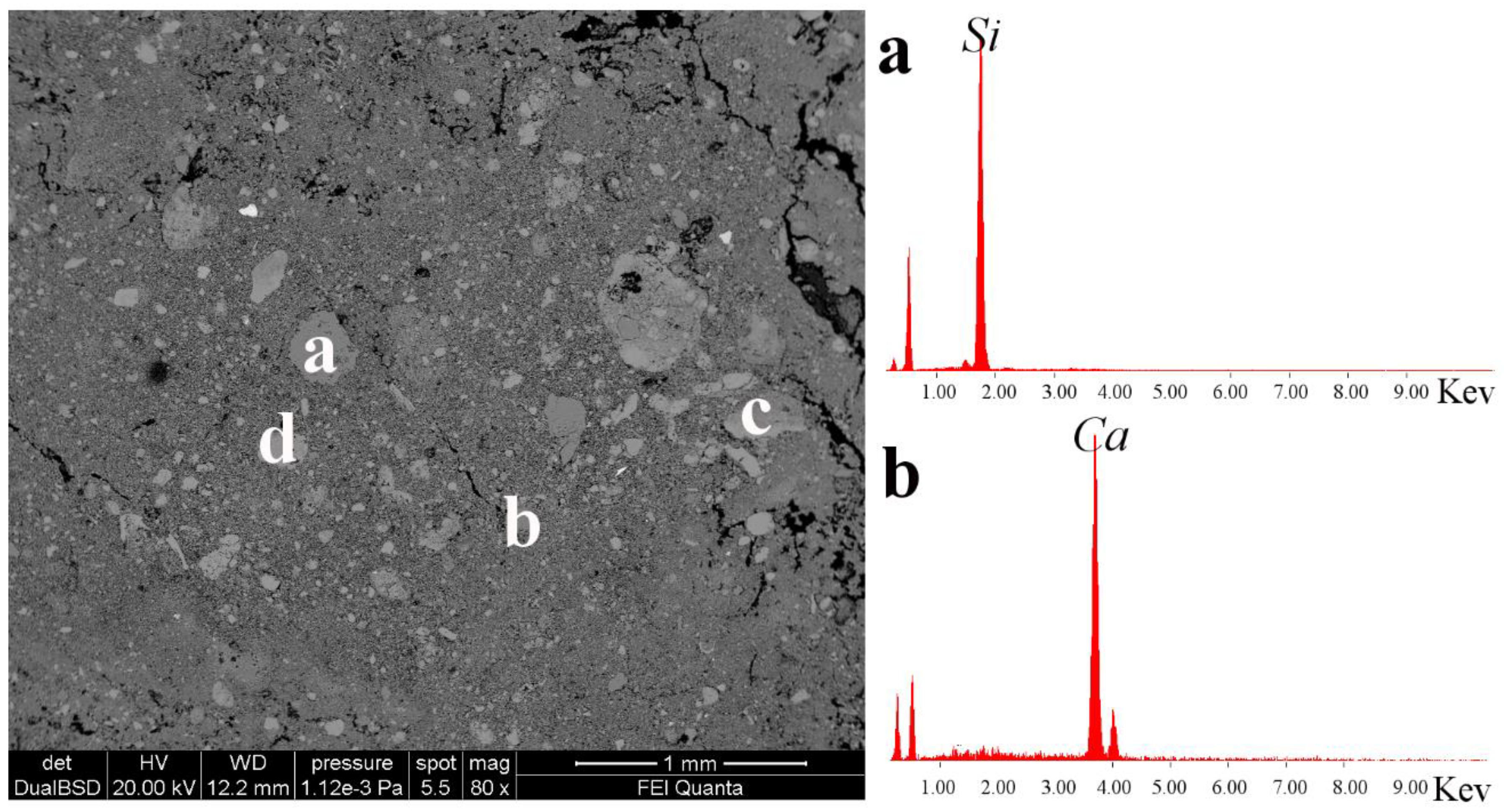



| General Chronological Sequence | Arslantepe Periods | Dendrochronology 14C Calibrated Date |
|---|---|---|
| Late Roman and Byzantine Age | I | |
| Iron Age | II–III | 1100–712 BCE |
| Late Bronze Age II | IV | 1600–1200 BCE |
| Late Bronze Age I | VB | 1750–1600 BCE |
| Middle Bronze | VA | 2000–1750 BCE |
| Early Bronze Age III | VID | 2500–2000 BCE |
| Early Bronze Age II | VIC | 2750–2500 BCE |
| Early Bronze Age I | VI B2–B1 | 3100–2750 BCE |
| Late Chalcolithic 5 (Late Uruk) | VIA | 3400–3100 BCE |
| Late Chalcolithic 3–4 | VII | 3800–3400 BCE |
| Late Chalcolithic 1–2 | VIII | 4250–3800 BCE |
| Sample | Binder | Aggregate | Porosity | Notes |
|---|---|---|---|---|
| A900 M2 VII 2007/102 | air-hardening calcium-rich lime homogeneous micritic texture | quartz calcite clay minerals | irregular shape no orientation secondary calcite | B/A < 1:3 |
| A950 M1 VII 2017/1 | air-hardening calcium-rich lime homogeneous micritic texture | quartz calcite plagioclase clinopyroxene siliceous rock fragments clay minerals uncalcined lumps charcoal fragments | irregular shape no orientation secondary calcite | B/A < 1:3 |
| D7(3) A1469 M3 VII 2018/257 | air-hardening calcium-rich lime homogeneous micritic texture | sub-rounded quartz clay minerals pyroxene uncalcined lumps charcoal fragments | irregular shape no orientation secondary calcite | B/A < 1:3 Four layers |
| D6(12) A1489 13a VII 2018/108 | air-hardening calcium-rich lime homogeneous micritic texture | sub-rounded quartz calcite clinopyroxene clay minerals uncalcined lumps | irregular shape no orientation secondary calcite | B/A < 1:3 The external part is less rich in aggregate than the internal one |
| Sample | Qtz | Cal | Pl | Ill-Mnt | Dol | Cpx | Sp |
|---|---|---|---|---|---|---|---|
| A900 M2 VII 2007/102 | tr | ++++ | ++ | tr | |||
| A950 M1 VII 2017/1 | ++ | ++++ | tr | ++ | tr | ||
| D7(3) A1469 M3 VII 2018/257 | ++ | ++++ | + | + | |||
| D6(12) A1489 13a VII 2018/108 | + | ++++ | ++ | tr | |||
| A900 RM3 VII 2011/1135 | ++++ | + |
Publisher’s Note: MDPI stays neutral with regard to jurisdictional claims in published maps and institutional affiliations. |
© 2021 by the authors. Licensee MDPI, Basel, Switzerland. This article is an open access article distributed under the terms and conditions of the Creative Commons Attribution (CC BY) license (http://creativecommons.org/licenses/by/4.0/).
Share and Cite
Mignardi, S.; De Vito, C.; Botticelli, M.; Favero, G.; Balossi Restelli, F.; Marinacci, L.; Alkhasoneh, S.; Medeghini, L. Lime Production in the Late Chalcolithic Period: The Case of Arslantepe (Eastern Anatolia). Heritage 2021, 4, 91-104. https://doi.org/10.3390/heritage4010005
Mignardi S, De Vito C, Botticelli M, Favero G, Balossi Restelli F, Marinacci L, Alkhasoneh S, Medeghini L. Lime Production in the Late Chalcolithic Period: The Case of Arslantepe (Eastern Anatolia). Heritage. 2021; 4(1):91-104. https://doi.org/10.3390/heritage4010005
Chicago/Turabian StyleMignardi, Silvano, Caterina De Vito, Michela Botticelli, Gabriele Favero, Francesca Balossi Restelli, Luca Marinacci, Samah Alkhasoneh, and Laura Medeghini. 2021. "Lime Production in the Late Chalcolithic Period: The Case of Arslantepe (Eastern Anatolia)" Heritage 4, no. 1: 91-104. https://doi.org/10.3390/heritage4010005
APA StyleMignardi, S., De Vito, C., Botticelli, M., Favero, G., Balossi Restelli, F., Marinacci, L., Alkhasoneh, S., & Medeghini, L. (2021). Lime Production in the Late Chalcolithic Period: The Case of Arslantepe (Eastern Anatolia). Heritage, 4(1), 91-104. https://doi.org/10.3390/heritage4010005








